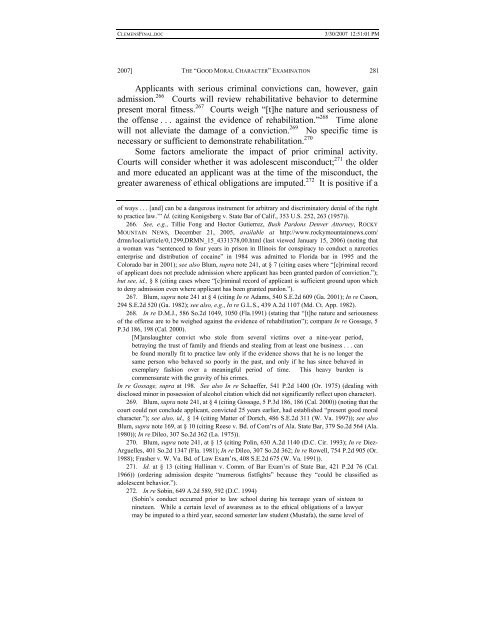Facing the Klieg Lights: Understanding the "Good Moral Character"
Facing the Klieg Lights: Understanding the "Good Moral Character"
Facing the Klieg Lights: Understanding the "Good Moral Character"
Create successful ePaper yourself
Turn your PDF publications into a flip-book with our unique Google optimized e-Paper software.
CLEMENSFINAL.DOC<br />
3/30/2007 12:51:01 PM<br />
2007] THE “GOOD MORAL CHARACTER” EXAMINATION 281<br />
Applicants with serious criminal convictions can, however, gain<br />
admission. 266 Courts will review rehabilitative behavior to determine<br />
present moral fitness. 267 Courts weigh “[t]he nature and seriousness of<br />
<strong>the</strong> offense . . . against <strong>the</strong> evidence of rehabilitation.” 268 Time alone<br />
will not alleviate <strong>the</strong> damage of a conviction. 269 No specific time is<br />
necessary or sufficient to demonstrate rehabilitation. 270<br />
Some factors ameliorate <strong>the</strong> impact of prior criminal activity.<br />
Courts will consider whe<strong>the</strong>r it was adolescent misconduct; 271 <strong>the</strong> older<br />
and more educated an applicant was at <strong>the</strong> time of <strong>the</strong> misconduct, <strong>the</strong><br />
greater awareness of ethical obligations are imputed. 272 It is positive if a<br />
of ways . . . [and] can be a dangerous instrument for arbitrary and discriminatory denial of <strong>the</strong> right<br />
to practice law.’” Id. (citing Konigsberg v. State Bar of Calif., 353 U.S. 252, 263 (1957)).<br />
266. See, e.g., Tillie Fong and Hector Gutierrez, Bush Pardons Denver Attorney, ROCKY<br />
MOUNTAIN NEWS, December 21, 2005, available at http://www.rockymountainnews.com/<br />
drmn/local/article/0,1299,DRMN_15_4331378,00.html (last viewed January 15, 2006) (noting that<br />
a woman was “sentenced to four years in prison in Illinois for conspiracy to conduct a narcotics<br />
enterprise and distribution of cocaine” in 1984 was admitted to Florida bar in 1995 and <strong>the</strong><br />
Colorado bar in 2001); see also Blum, supra note 241, at § 7 (citing cases where “[c]riminal record<br />
of applicant does not preclude admission where applicant has been granted pardon of conviction.”);<br />
but see, id., § 8 (citing cases where “[c]riminal record of applicant is sufficient ground upon which<br />
to deny admission even where applicant has been granted pardon.”).<br />
267. Blum, supra note 241 at § 4 (citing In re Adams, 540 S.E.2d 609 (Ga. 2001); In re Cason,<br />
294 S.E.2d 520 (Ga. 1982); see also, e.g., In re G.L.S., 439 A.2d 1107 (Md. Ct. App. 1982).<br />
268. In re D.M.J., 586 So.2d 1049, 1050 (Fla.1991) (stating that “[t]he nature and seriousness<br />
of <strong>the</strong> offense are to be weighed against <strong>the</strong> evidence of rehabilitation”); compare In re Gossage, 5<br />
P.3d 186, 198 (Cal. 2000).<br />
[M]anslaughter convict who stole from several victims over a nine-year period,<br />
betraying <strong>the</strong> trust of family and friends and stealing from at least one business . . . can<br />
be found morally fit to practice law only if <strong>the</strong> evidence shows that he is no longer <strong>the</strong><br />
same person who behaved so poorly in <strong>the</strong> past, and only if he has since behaved in<br />
exemplary fashion over a meaningful period of time. This heavy burden is<br />
commensurate with <strong>the</strong> gravity of his crimes.<br />
In re Gossage, supra at 198. See also In re Schaeffer, 541 P.2d 1400 (Or. 1975) (dealing with<br />
disclosed minor in possession of alcohol citation which did not significantly reflect upon character).<br />
269. Blum, supra note 241, at § 4 (citing Gossage, 5 P.3d 186, 186 (Cal. 2000)) (noting that <strong>the</strong><br />
court could not conclude applicant, convicted 25 years earlier, had established “present good moral<br />
character.”); see also, id., § 14 (citing Matter of Dortch, 486 S.E.2d 311 (W. Va. 1997)); see also<br />
Blum, supra note 169, at § 10 (citing Reese v. Bd. of Com’rs of Ala. State Bar, 379 So.2d 564 (Ala.<br />
1980)); In re Dileo, 307 So.2d 362 (La. 1975)).<br />
270. Blum, supra note 241, at § 15 (citing Polin, 630 A.2d 1140 (D.C. Cir. 1993); In re Diez-<br />
Arguelles, 401 So.2d 1347 (Fla. 1981); In re Dileo, 307 So.2d 362; In re Rowell, 754 P.2d 905 (Or.<br />
1988); Frasher v. W. Va. Bd. of Law Exam’rs, 408 S.E.2d 675 (W. Va. 1991)).<br />
271. Id. at § 13 (citing Hallinan v. Comm. of Bar Exam’rs of State Bar, 421 P.2d 76 (Cal.<br />
1966)) (ordering admission despite “numerous fistfights” because <strong>the</strong>y “could be classified as<br />
adolescent behavior.”).<br />
272. In re Sobin, 649 A.2d 589, 592 (D.C. 1994)<br />
(Sobin’s conduct occurred prior to law school during his teenage years of sixteen to<br />
nineteen. While a certain level of awareness as to <strong>the</strong> ethical obligations of a lawyer<br />
may be imputed to a third year, second semester law student (Mustafa), <strong>the</strong> same level of
















